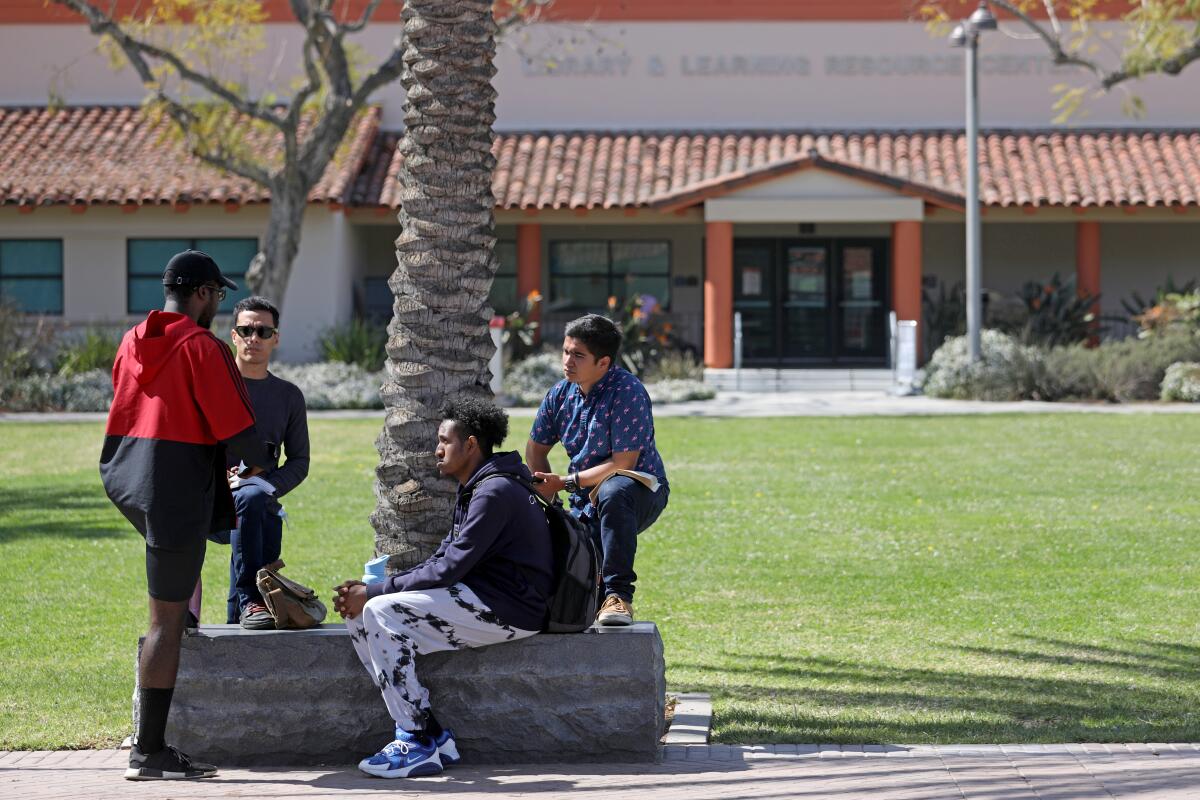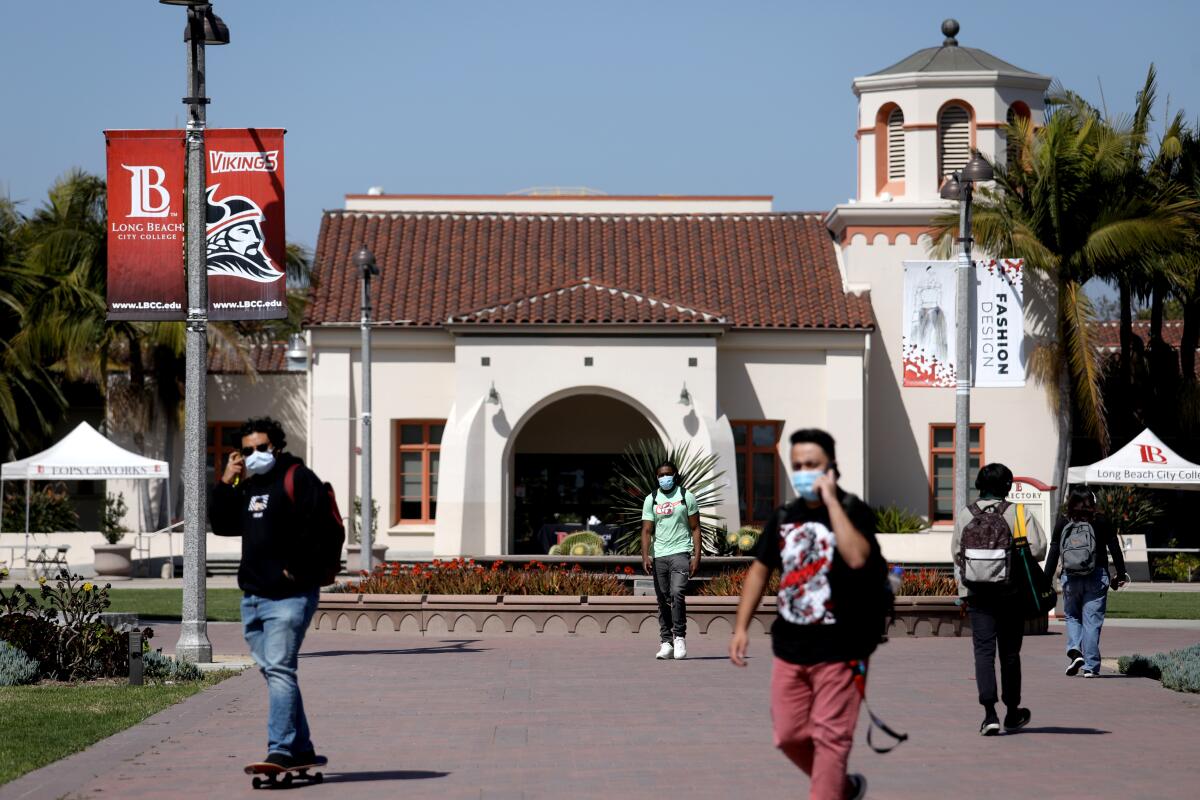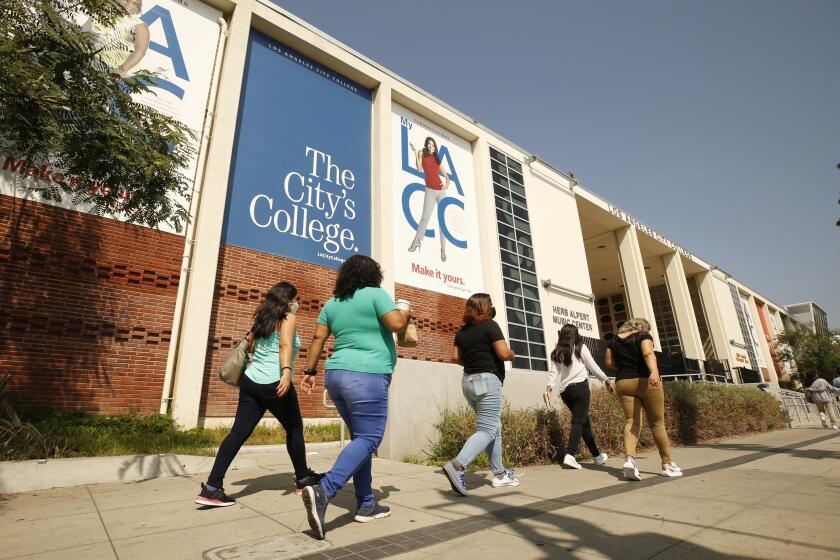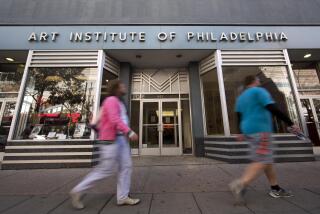Overdue tuition and fees, even $41, can derail a community college education

- Share via
In the spring of 2021, $600 stood between Endele Wilson and his dream of earning a teaching credential from Long Beach City College.
Wilson, 47, started taking courses in 2019, a few months before the pandemic hit and just before he lost his job as an elementary school music teacher. He took on multiple jobs as a musician and found an overnight shift at a gas station to support his eight children.
When he was about 18 units away from completion, he got the bill that stopped him in his tracks. He didn’t qualify for financial aid, he said, because of low grades years ago at another community college. Confronted with $600 in unpaid enrollment fees, he couldn’t register for classes until he settled the balance.
“I didn’t know what to do,” Wilson recalled. “Even working two jobs, I don’t make enough money to do anything but survive.”
Enrollment at California Community Colleges has plummeted nearly 20% during the pandemic to about 1.3 million students from fall 2019 to fall of 2021, according to state data, leaving campuses worried about their future, and potential students with fewer opportunities offered by higher education.
College officials have said pandemic-related hardships have propelled students to choose jobs over education, and online classes were barriers for low-income students without digital resources.
But new research suggests that colleges’ policies around unpaid balances may also be contributing to the enrollment decline, while creating lasting financial harm for the institutions and students.
A report published Thursday by the Student Borrower Protection Center, a nonprofit advocacy group focused on student debt, attempts to quantify the scope of the issue. Using data from three California Community College districts and student demographic information, researchers estimate that from July 2020 to June 2021, some 321,000 community college students accrued a collective $107 million in debt to their campuses.
Researchers projected estimates for the system based on the percentage of students affected in three diverse districts: Compton, Lake Tahoe and Peralta, in northern Alameda County. The report was provided jointly to The Hechinger Report, a nonprofit newsroom covering education, and The Times.
In addition, The Hechinger Report obtained data from seven community college districts, representing 19 of the 116 community colleges in the California system. Though there is variation in what each district tracks, the data show tens of thousands of students in debt to their community colleges, roughly in line with the researchers’ estimate. The records include data on a range of institutional debts from colleges and districts including Evergreen Valley College in San Jose, the three-campus Contra Costa College District, the nine-campus Los Angeles Community College District and the three campuses of the Coast Community College District in Orange County.
California Community College students can decide whether they want a letter grade, a pass/no pass credit — a transcript lifeline of sorts designed to prevent students from dropping out.
The pain from these debts is not felt evenly, researchers said.
“They impact low-income students at a much higher rate,” said Charlie Eaton, assistant professor of sociology at the University of California, Merced and co-author of the report. “These debts are widening inequalities in who gets a degree, and it inflicts financial turmoil.”
When students owe money to their colleges — even small amounts — they can be barred from re-enrolling. Schools can refer students to state tax collectors to have their tax refund garnished or send them to debt collection companies, which often charge high fees. Colleges often don’t recoup much money, and former students can have their credit destroyed.
Students accrue the debt for a number of reasons, according to experts and college officials. Sometimes, they enter into a payment plan for tuition and can’t keep up. Other times, they’ve paid tuition in full, but owe money for overdue parking, library or housing fees. Sometimes students owe a fine after failing to return a computer or calculator on time.

The number of students in this situation likely grew during the pandemic, Eaton said, although it’s difficult to know by how much. It’s not known how many students wanted to re-enroll but were prevented from doing so because of their debt. The California Community College chancellor’s office does not track this information. Nor does it keep tabs on what happens to a student in debt. It also doesn’t regulate how colleges handle unpaid fees.
Chancellor Eloy Ortiz Oakley acknowledged the problem.
“Too many students are struggling with hardships that make even modest debts a barrier to enrollment in community colleges,” he said.
Oakley said community college students who needed financial assistance during the pandemic are some of the “most deserving recipients” of federal relief, and believes they are worthy of investment due to their overall impact on the economy.
“We also know that for every dollar taxpayers invest in community college students, they see a significant return on that investment over the life of the student,” he said.
The cost of community college varies based on how many units a student takes and the price of textbooks. One Los Angeles campus estimates an annual cost of more than $2,300 in tuition, enrollment fees and books based on a 14-unit course load; a campus in Northern California estimates $2,500 for the school year. That does not include expenses for transportation, housing and other basic needs.

Community college tuition can be free for students in good academic standing who qualify for state and federal grants through the federal financial aid application FAFSA. The California Promise Program waives enrollment fees, as does a Los Angeles-specific program.
But Eaton and his fellow researchers uncovered ways in which students can get tangled in financial aid bureaucracy. Some colleges allow students to enroll before their financial aid is approved and disbursed, they found. If they fill out the paperwork incorrectly, they can receive less money than expected and can’t bridge the gap.
Or, when students withdraw partway through the semester, schools must return their federal financial aid to the Department of Education, and the students must repay their school, even if they only attended classes for a few weeks. The Department of Education currently offers waivers for this process, if a college can prove a student dropped out for a pandemic-related reason, but available data show that many students haven’t gotten relief.
Some 2,100 students in the Los Angeles Community College District who withdrew between fall 2019 and summer 2021 owed federal aid reimbursement money to their school, according to data from district officials produced in early March. In total, data showed that students owed the district $10 million for all debts.
District data and survey responses reveal a disappointing semester for L.A. community college students, many of whom lacked access to technology, quiet study space and basic needs.
Compton College decided to clear 2,702 students’ debt during the pandemic, to keep them enrolled, said President Keith Curry.
The median debt forgiven was just $41.
“If you owe $41, and you’re not coming back to school because you owe $41, that’s problematic,” Curry said.
California’s public colleges and universities have wide discretion in how to handle student debt collection, and practices vary. Some try to collect the money on their own. Others use private debt collection agencies. Some forward the debt to the state Franchise Tax Board to garnish tax refunds.
Although some schools paused the use of debt collectors during the pandemic, the practice can have “lasting effects on your ability to rent an apartment, to get a car loan, to get a credit card and to fully participate in the economy,” Eaton said.
Meanwhile, the chancellor’s office has continued running its “tax-offset program.” Participating schools send the office names of students with past-due balances, and the information is sent to the state Franchise Tax Board. Students then may have their state tax refund and any lottery winnings garnished. According to the chancellor’s office, 21 districts, including Los Angeles, Long Beach and Riverside, serving about 96,000 students participate in the program. Seven others are seeking to participate.
Officials at Rio Hondo Community College in Whittier decided to pause participation in the tax-offset program for current students before the start of the pandemic and will not restart for at least three more years, said Stephen Kibui, vice president of finance and business. The campus typically gets back about 40% of what it’s owed after allowing for a 25% administrative fee, he said.
The college also previously worked with a debt collector, but scrapped that when the 33% fee was too high, and students’ credit was being damaged.
For now, Rio Hondo is using federal relief money to waive current student debt, which Kibui says benefits both students and the college. The campus has lost more than 8,000 students since 2018-19, with enrollment dropping from 33,500 to 25,000.
“The college is in dire need of students,” Kibui said. “We are not adding any financial hardships to any of our students.”
Several other community colleges and universities across the state — including the Los Angeles Community College district — have used their federal relief funds to forgive student debt, in hopes that students will stay enrolled or dropouts will return. The LACCD colleges canceled about $20.2 million in student debts, according to a spokesperson. Just under $10 million in debt remains from the previous two academic years, according to district records.
Long Beach City College, for example, has forgiven $2.1 million in debt for 7,990 students from spring 2020 to summer 2021, according to the interim executive vice president of student service, Nohel C. Corral. Individual debts forgiven ranged from $100 to $5,000.

The decision meant thousands were able to continue with their education. Wilson was one of them.
For him, the timing was critical. If his debt were not forgiven, “I would have had to stop school,” he said. “It’s my hypothesis that if people stop for two semesters, it’s not as easy to get started again — I could have easily been fully sidetracked.”
This story was reported in partnership with The Hechinger Report, a nonprofit newsroom covering education issues. Butrymowicz, D’Amato and Kolodner reported for the Hechinger Report. Colleen Shalby is a Times staff writer.
More to Read
Sign up for Essential California
The most important California stories and recommendations in your inbox every morning.
You may occasionally receive promotional content from the Los Angeles Times.












